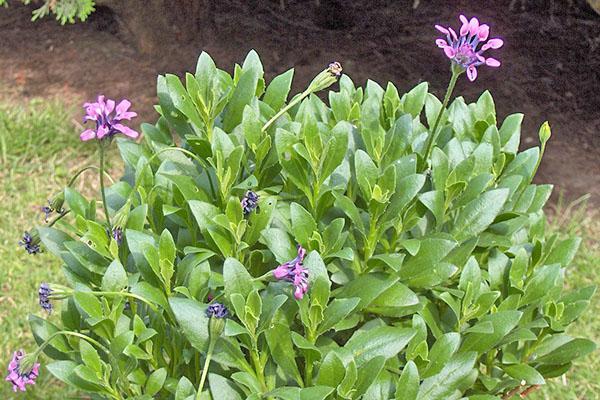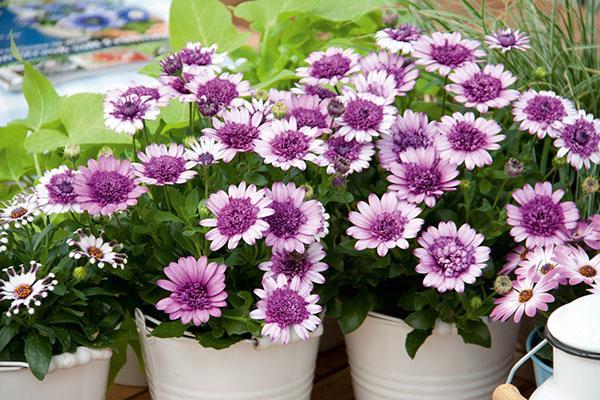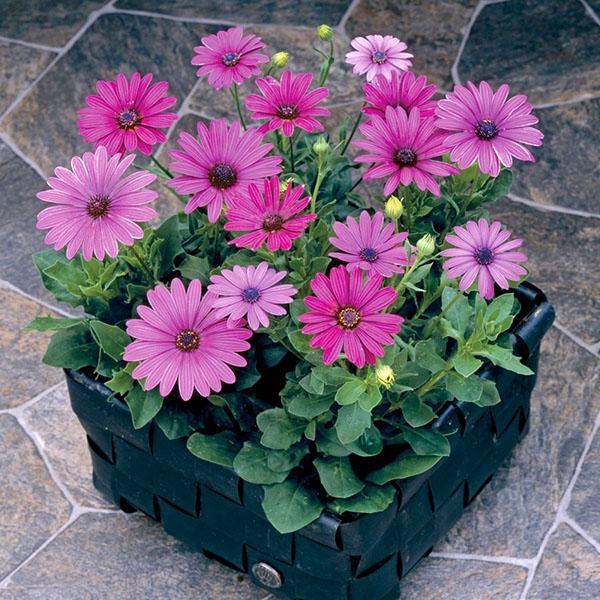Proper cultivation and care of osteospermum
 In order for the cultivation and care of osteospermum to be a breeze, it is enough to follow simple rules. The flower is not picky about the growth conditions. It is able to survive in any weather and on a variety of soils.
In order for the cultivation and care of osteospermum to be a breeze, it is enough to follow simple rules. The flower is not picky about the growth conditions. It is able to survive in any weather and on a variety of soils.
Osteospermum plant: characteristics and types

The shade of the flowers is influenced by the planting location and the amount of light.
Loose buds are double inflorescences up to 6 cm in diameter. Flowers are divided into extreme and central. The lateral ones are often purple and white, and the central ones are blue or light blue.
The inflorescences do not lose their attractiveness for about 5 days, and when they wither, fresh buds appear in their place. Therefore, osteospermum blooms for a long time. With proper care and favorable weather conditions, flowering continues until mid-October.
The buds open only in clear weather closer to noon, and close immediately after sunset. On rainy and cloudy days, you won't be able to see the beauty of the inflorescences. This protects the pollen from wind, rain and night dew.
The least common varieties are those whose flowers have warm shades (yellow, orange, red).
Main types:
- Osteospermum Pass blooms in a purple or pink shade. The diameter of the opened bud is about 4.5 cm. Passion grows small, so it is grown as a houseplant.

- Osteospermum Cool. The annual plant is presented in the form of a small bush. The flower is not unpretentious to weather conditions. It tolerates high and low temperatures well. The flowers are chamomile-shaped, 7 cm in diameter.

- Osteospermum Asti. Small bushes with medium flowers (5 cm in diameter). The plant is resistant to drought, wind, heat, light frost. Flowering is abundant enough, lasts until the end of November.

- In our region, ampelous osteospermum is quite popular. You can grow the flower as a houseplant in jugs or pots. The species is very fond of the sun, and if you plant a bush in an open area, then it will bloom for a long time and profusely.

- Osteospermum Akila Parple. The species is frost resistant. Differs in bright purple flowers.

- Osteospermum Accord. This is an annual, fairly tall plant. The daisies have a diameter of 4.5 cm. The buds have a blue center and white edging. Flowering continues from early summer to late autumn.

Osteospermum: growing seedlings
 For growing a plant, the method of cuttings or planting seeds is suitable. Some varieties can only be grown from grains. Moreover, the planting material is sown directly into the open ground, in that permanent place. The disadvantage of this reproduction is late flowering. To achieve early bud formation, seedlings should be grown initially.
For growing a plant, the method of cuttings or planting seeds is suitable. Some varieties can only be grown from grains. Moreover, the planting material is sown directly into the open ground, in that permanent place. The disadvantage of this reproduction is late flowering. To achieve early bud formation, seedlings should be grown initially.
In order for the seeds to begin and sprout sooner, you should crush their dense shell before planting.
Time of planting seeds for seedlings
 In order to get early flowering, you need to sow seeds for seedlings in the last days of March. The plant needs warmth to start germinating. Temperature from +18 to +200C is the most optimal. After a week and a half, the seeds will begin to sprout.
In order to get early flowering, you need to sow seeds for seedlings in the last days of March. The plant needs warmth to start germinating. Temperature from +18 to +200C is the most optimal. After a week and a half, the seeds will begin to sprout.
Seedling substrate
When placing the plant in the soil, make sure it is loose. The soil should consist of turf, fallen leaves, humus and sand. The substrate can be prepared by mixing sand and peat in equal proportions.
Seeding rules
Since the grains of osteospermum are large enough, they germinate well. If you plan to grow indoor species, then the seeds are planted immediately in pots. Thus, the risk of damaging the root system during plant transplantation is eliminated. It is not recommended to deeply bury the planting material, it is enough to press it into the ground by half a centimeter, and cover it with earth.
In order for the seeds to sprout well, they should only be taken dry. Soaking will not improve germination. Better to just put them in a damp cloth or tissue.
Containers with planted seeds should be covered with glass or a thick film, put in a warm, bright place. The seedlings will grow quite quickly only if you provide it with a lot of sun and a temperature of at least +200 C. It is recommended to keep containers on windows that face south or west.
Seedling: care and subsequent planting
 While you are growing seedlings, water them sparingly, without overmoistening. Top dressing is carried out only one, 15 days before planting in the ground. This moment falls in the middle of spring. Mineral and organic formulations are good options.
While you are growing seedlings, water them sparingly, without overmoistening. Top dressing is carried out only one, 15 days before planting in the ground. This moment falls in the middle of spring. Mineral and organic formulations are good options.
Some gardeners discuss the need to pinch the plant. The procedure is carried out two times before disembarking in open ground. Pinching helps to slow down the stretching of the plant, which helps to form a beautiful bush in time. In addition, the plant will bloom much better.
Hardening of seedlings
Osteospermum is cold-resistant, but hardening will not hurt it. It is necessary to accustom the seedlings from the moment when leaves begin to appear on it. Then the temperature should be reduced, for example, letting in cold air into the room. The first procedure should not last longer than 12 minutes. Next, we increase the hardening time and reduce the temperature to +110 FROM.
As soon as the night frosts stop outside, it's time to transfer the osteosmermum seedlings to open soil.
Favorable period for disembarkation
 At the time of disembarkation, you should have a strong escape. Seedlings should be transferred to the ground in late spring - early summer, when the weather will be stably warm.
At the time of disembarkation, you should have a strong escape. Seedlings should be transferred to the ground in late spring - early summer, when the weather will be stably warm.
Seedlings should be planted in an area that is well warmed by the sun. The main thing is that there are no harsh winds here. The soil for the plant should be fertile, loose, fertilized.
The planting process is best done on a sunny and warm day. Seedlings need to be dug out of the container along with the ground and placed in the prepared hole. Tamp the soil and then pour water over it. A large distance must be maintained between the plants. It should be approximately 50-100 cm.
Osteospermum cuttings
 Another way of plant propagation is cuttings. Procurement of planting material should be done at the end of summer. Cut the cuttings diagonally at the top of the plant. Each of them should have several sheets.
Another way of plant propagation is cuttings. Procurement of planting material should be done at the end of summer. Cut the cuttings diagonally at the top of the plant. Each of them should have several sheets.
Leave the cuttings in water for a month, and only then transplant them into pots. Potted substrate should contain sand, earth, and humus. Next, the cuttings are sprayed with fertilizer and covered with a film. It is also required to maintain a temperature regime of about +180 C. We follow the sprouts until spring, and as soon as the night frosts are over, they can be moved to open ground.
Growing and caring for osteospermum
 If you take proper care of osteospermum, then you will grow an unpretentious, attractive and pleasant flower.
If you take proper care of osteospermum, then you will grow an unpretentious, attractive and pleasant flower.
Watering mode
Water the plant regularly and in moderation. Take only warm and settled water. They also use rainwater. Do not forget about this, especially in heat or drought. In winter, watering should be done so that the soil is not dry.
After each irrigation, it is recommended to remove all weeds and loosen the soil. This will help the bush to have good immunity and receive all the necessary trace elements and vitamins.
Plant feeding
During the season, the plant should be fed three times: in this way it will turn out to prolong flowering, and the loose buds will acquire a rich, bright shade. The first time to fertilize the shoots should be three weeks after planting. The second feeding is carried out before flowering, when the buds are just beginning to tie. And the third is held at the end of August. You can fertilize osteospermum with potassium saltpeter or superphosphate, following the instructions. You can use special complex compositions for flowers.
Pruning inflorescences
In order for the bush to delight with its beauty throughout the warm season, it is recommended to systematically remove dry flowers. If this is not done, they will interfere with the formation of new, healthy buds.
Osteospermum wintering
 African chamomile is best grown as a perennial plant. To do this, for the winter, osteospermum should be placed in a cool and bright room. In the cold months, watering the flower should be kept to a minimum, because excess moisture in the cold will be detrimental to the plant.
African chamomile is best grown as a perennial plant. To do this, for the winter, osteospermum should be placed in a cool and bright room. In the cold months, watering the flower should be kept to a minimum, because excess moisture in the cold will be detrimental to the plant.
Leaving the plant in the open field for the winter is possible only in the southern regions, where the air temperature does not drop below -80 S. But, despite this, the flower should be carefully covered with a special canvas, which is removed with the onset of spring.
Low-growing types of osteospermum are very fond of gardeners and designers. Such plants look great in a flower bed, they do not take up much space and calmly get along with other flowers. African daisies grow well in pots, so when creating flower arrangements, they are perfect.